
Hyundai Rotem Co. is a South Korean company that manufactures rolling stock, defense products and plant equipment. It is a part of the Hyundai Motor Group. Its name was changed from Rotem to Hyundai Rotem in December 2007 to reflect the parent company. It is also called Hyundai Railroad Technology Systems.
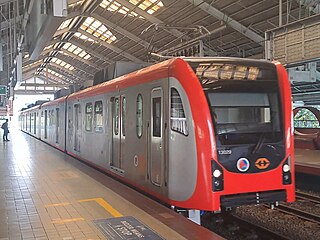
The Manila Light Rail Transit System, commonly known as the LRT, is an urban rail transit system that primarily serves Metro Manila, Philippines. Although categorized as a light rail system because it originally used light rail vehicles, it presently has characteristics of a rapid transit system, such as high passenger throughput, exclusive right-of-way, and later use of full metro rolling stock. The LRT is jointly-operated by the Light Rail Transit Authority (LRTA), a government corporation attached to the Department of Transportation (DOTr), and the Light Rail Manila Corporation (LRMC). Along with the Manila Metro Rail Transit System and the Metro Commuter Line of the Philippine National Railways, the system makes up Metro Manila's rail infrastructure.
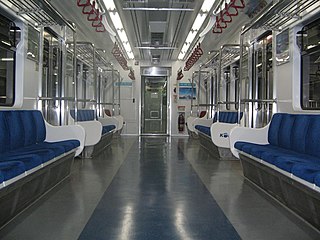
There are many types of trains in Seoul but they are generally similar to each other. All Seoul Metropolitan Subway rolling stock follow the Japanese-style commuter/subway train interior layout of all-longitudinal seating with luggage racks above seats. Typically, train cars have four pairs of doors on each side. In between the doors are rows of either cushioned or non-cushioned seats for 7 people, except for the outer ends of each wagon where there are smaller rows of seats for 3 people, marked for the use by the elderly, disabled passengers, and pregnant women.
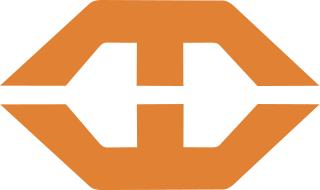
The Light Rail Transit Authority (LRTA) is a public transport operator that is responsible for the construction, operation, maintenance and/or lease of Manila Light Rail Transit System in the Philippines. It is organized as a government-owned and controlled corporation under the Department of Transportation (DOTr) as an attached agency.

The Light Rail Transit Line 1, commonly referred to as LRT Line 1 or LRT-1, is a light rapid transit system line in Metro Manila, Philippines, operated by Light Rail Manila Corporation (LRMC) and owned by the Light Rail Transit Authority (LRTA) as part of the Manila Light Rail Transit System. Originally referred to as Metrorail and the Yellow Line, LRT Line 1 was reclassified to be the Green Line in 2012. It travels in a general north–south direction from Baclaran to Monumento, and then east–west from Monumento to Fernando Poe Jr. Currently, the line consists of 20 stations and runs on 19.65 kilometers of fully elevated route. Although it has the characteristics of light rail, such as with the type of rolling stock used, it is more akin to a rapid transit system owing to its total grade separation and high passenger throughput.

The Light Rail Transit Line 2, also known as LRT Line 2,LRT-2 or Megatren, is a heavy rail rapid transit line in Metro Manila in the Philippines, generally running in an east–west direction along the Radial Road 6 and a portion of the Circumferential Road 1, referred to as the Purple Line, and previously known as the Mass Rapid Transit Line 2 or MRT Line 2 (MRT-2).

A medium-capacity system (MCS), also known as light rapid transit or light metro, is a rail transport system with a capacity greater than light rail, but less than typical heavy-rail rapid transit. MCS's trains are usually 1–4 cars. Most medium-capacity rail systems are automated or use light rail type vehicles.
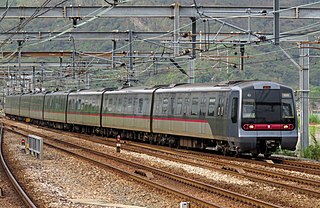
The Rotem EMU is an electric multiple unit that operates on the MTR rapid transit railway system in Hong Kong. They were jointly built by a consortium consisting of Mitsubishi Heavy Industries of Japan and Hyundai Rotem of South Korea and come in two variants: TKE-C651 was delivered for the Tseung Kwan O line, and TKE-C6522-04E delivered in 2006 to 2007 for the Tung Chung line. In 2003 and 2004, the urban line trains ran on the Tsuen Wan line, Island line and Tseung Kwan O line.

The Manila Metro Rail Transit System (MRTS), commonly known as the MRT, is a rapid transit system that primarily serves Metro Manila, Philippines. Along with the Manila Light Rail Transit System and the Metro Commuter Line of the Philippine National Railways, the system makes up Metro Manila's rail infrastructure.
The Light Rail Transit Line 6 is a proposed rapid transit system in Cavite, Philippines. There have been two proposals for the line, with the first one shelved immediately in 2018. Another proposal emerged in 2017 and is currently under review by the National Economic and Development Authority (NEDA).

The Taipei Metro C341 is the third generation of electric multiple units on the Taipei Metro in Taipei, Taiwan. Built by Siemens Mobility and SGP Verkehrstechnik in Austria, it was introduced on the Bannan line in 2004.

The Metro Rail Transit Line 7, also known as MRT Line 7 or MRT-7, is a rapid transit line under construction in the Philippines. When completed, the line will be 22.8 kilometers long, with 14 stations, and the first line to have a third rail electrification. The line runs in a northeast–southwest direction, beginning at San Jose del Monte, Bulacan up to the North Triangle Common Station in North Avenue, Quezon City.

The LRTA 1000 class is the first-generation class of high-floor light rail vehicles (LRV) currently operated by the Light Rail Manila Corporation. It first entered service under the Light Rail Transit Authority in 1984 on the LRT Line 1.
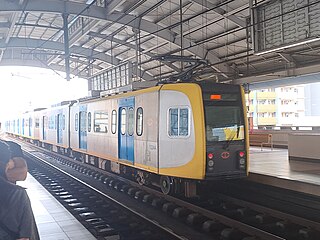
The LRTA 1200 class is the third-generation class of high-floor light rail vehicles (LRV) of the Light Rail Transit Authority servicing the Manila LRT Line 1. Purchased as part of the second phase of the capacity expansion of the line, the trains entered service in December 2006.

The LRTA 1100 class is the second-generation class of high-floor light rail vehicles of the Light Rail Transit Authority (LRTA) in Manila, Philippines, which began operation in 1999.

The LRTA 13000 class is a class of fourth-generation high-floor light rail vehicles (LRV) of the Light Rail Transit Authority servicing the Manila LRT Line 1. Purchased in 2017 as part of the south extension of the line, the trains entered service in July 2023 to replace the aging first-generation 1000 class trains.

The EMU900 series is a series of electric multiple unit passenger trains owned by Taiwan Railway (TR). Manufactured in South Korea by Hyundai Rotem, the trains are used on Local and Fast Local services, which stop at most stations. They entered service on 6 April 2021.
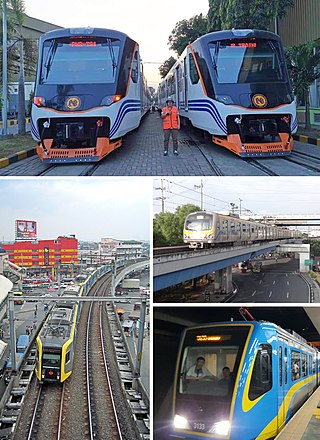
Rail transportation in the Greater Manila Area is a major part of the transportation system in Metro Manila and its surrounding areas. It consists of the Manila Light Rail Transit System, Manila Metro Rail Transit System, and the PNR Metro Commuter Line. The network makes up the majority of active railways in the country and bear the brunt of providing the metropolis with rail as a faster alternative mode of transport other than buses and jeepneys. However, these systems are currently insufficient for the rapidly expanding metropolis; to address this, new lines and line extensions are under construction, which will extend the system far out into neighboring regions.

The PNR EM10000 class is an electric multiple unit commuter trainset that will be operated by the Philippine National Railways on the North–South Commuter Railway. Prior to the reveal of its numbering scheme in October 2021, the train was known as the PNR Sustina Commuter. Set to enter service by 2023, it will be PNR's first trainset to be run on standard gauge and powered by electric traction. The trains are also designed to be interoperable with the Metro Manila Subway.
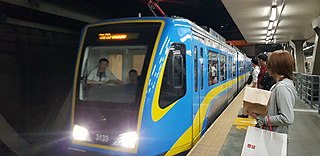
The MRTC 3100 class or CRRC Dalian 8MLB LRV, commonly called as the Dalian Train, is the class of second-generation uni-directional light rail vehicles built in China by CNR Dalian, now CRRC Dalian. Since its delivery, most of the trains are still being tested and undergoing final assessments, before being used on regular services on Line 3 of the Manila Metro Rail Transit System.
























